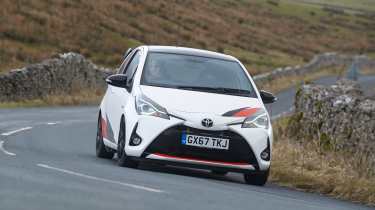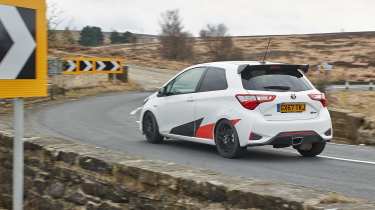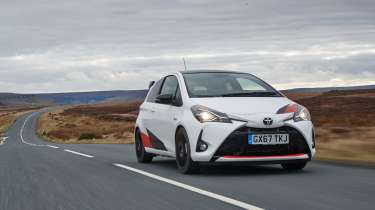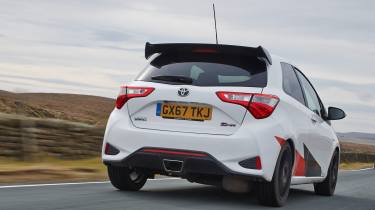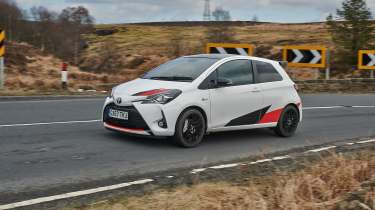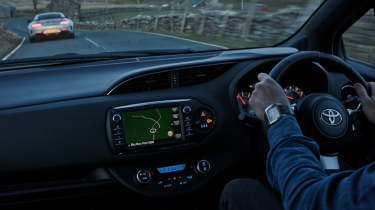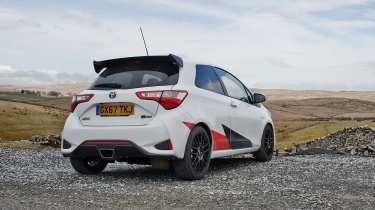Toyota Yaris GRMN (2017 - 2018) review – the forgotten Ford Fiesta ST killer?
Toyota Gazoo Racing sprung out the gates with the supercharged Yaris GRMN, a bombastic hot hatch that now hides in the shadow of the GR Yaris
Toyota Gazoo Racing sprung out the gates with the supercharged Yaris GRMN, a bombastic hot hatch that now hides in the shadow of the GR Yaris
What can only be described as the absolute furore that has surrounded Toyota’s rally refugee Yaris over the last few years leads us to question whether its predecessor, the Toyota Yaris GRMN (Gazoo Racing Masters of the Nürburgring, in case you’d forgotten), has faded from people’s minds? Granted, it is a rather more traditional hot hatch, with a potent motor fitted to a conventional front-driven chassis, rather than the near-bespoke device that the GR Yaris is, but that doesn’t mean the Yaris GRMN should slip into obscurity. It laid the foundations for Toyota’s commitment to the hot hatch genre.
At the time, the Toyota Yaris was an unlikely model to be tasked with launching the Gazoo Racing sub-brand in Europe but that’s exactly what the Yaris GRMN did. With a limited run of just 600 cars (400 in Europe and a further 200 restyled versions for the Japanese market) it was more of a toe in the water exercise than a full-on assault, as a precursor to the GR Yaris, GR86 and GR Supra. But its character set the tone for the raft of go-faster models from the Japanese firm.
Aimed squarely at the time at the likes of the Peugeot 208 GTI by Peugeot Sport and Ford Fiesta ST – a car that at the time was undergoing a generational transition from Mk7 to Mk8 – the Yaris hot hatch arrived after just two short years of development at the hands of a small team.
More reviews
Group tests
In-depth reviews
Long term tests
Reviews
If nothing else, this dedicated cohort of car nuts were keen to remind the world what we well know now; that Toyota still knows how to have fun. To this end, the Yaris GRMN packed a 209bhp supercharged 1.8-litre four-cylinder engine, a six-speed manual gearbox, heavily revised suspension and a limited slip differential.
The Yaris GRMN is actually a real hoot. For starters it’s genuinely quick, the mix of fizzy motor and closely stacked ratios making for rapid progress. And while the chassis lacks the ultimate finesse and poise of the Peugeot 208 GTi, it makes up for that with an infectious appetite for fun. Whereas the Peugeot remains a little aloof until you really dig deep, the Yaris goads you on from the getgo
Toyota Yaris GRMN engine and performance
Thumb the starter button and the supercharged 2ZR engine – one the Yaris GRMN shares with the Lotus Elise S3 – fires keenly, idling with a note that’s more vocal than the Peugeot 208 GTi’s.
The Yaris GRMN is in many ways defined by its ‘2ZR’ 1.8-litre supercharged engine. It’s a type of powerplant unique to the hot match market the GRMN entered, and while it uses forced induction its throttle response is superior to that of rivals that are all turbocharged.
It’s powerful, too, with a peak output of 209bhp and a slightly less impressive 184lb ft maximum torque output developed at a high 5000rpm. Clearly, it lacks the low-down punch of some, but the mid-range is surprisingly effective and most of all, it loves to be extended between 5000-7000rpm.
While there is the distant characteristic whine of a supercharger at lower revs, it’s the rush of compressed air and exhaust blare that you hear towards the red line. Crispness of response is its major advantage, complemented by a slick and precise gearchange.
The car’s outright performance figures are competitive rather than startling, with the 0-62mph dash taking a claimed 6.3 seconds – although the fact the sprint geared Yaris won’t crack 60mph in second, requiring a change to third, means this is a pretty impressive effort. Top speed is electronically pegged at 143mph.
Considerable work was needed to fit the big unit in the nose of the Yaris, with many of the challenges revolving around heat management and maintaining emissions compliance. The Magnusson-Eaton supercharger, its intercooler, and the air intake, are packaged as one, slotting down into the front of the engine bay. The exhaust was a particular headache, as there was no provision for the necessary shape and diameter of a performance pipe with the standard Yaris underfloor.
The only transmission option is a six-speed manual with a close ratio gearset. This drives the front-wheels through a Torsen limited slip differential.
Toyota Yaris GRMN handling
In normal driving the GRMN is surprisingly undemanding, with a ride that, while possessing an underlying firmness, is far from uncomfortable. There is perhaps a fraction more weight to the steering, but there’s still a slightly artificial manner to the way it self-centres and, in fact, during those first few degrees of lock when you turn into a corner.
It’s a glassy, remote kind of sensation, which on cold, wintry roads makes it easy to over-commit on the amount of steering lock required, and therefore overload the front tyres, which clearly don’t have the outright grip of the Michelin Supersports used by the Peugeot 208 GTi.
Nevertheless, get through this phase and it’s clear that the nose does stick, and the Yaris GRMN can be thrown down a road with manic enthusiasm, revs flaring, nose gently torque-steering under power but never requiring a firm hand, and all at very high speed.
The GRMN engineers consciously settled on a chassis tune that’s playful, but also one that strikes a fine balance between interaction, adjustability and confidence-breeding stability. It’s appreciably less tail happy than the 208, but no worse for it.
Perhaps the only real criticism is that the Yaris seems to quickly run out of suspension travel, which is no doubt down to the many limitations of the standard car. It never gets unruly and there’s just enough control at the very limit of compression, but it can sap a little confidence when really attacking a bumpy section of road. A 208 GTi is more controlled in similar conditions, but this poise comes at the expense of some communication at more realistic everyday speeds.
The Yaris GRMN underwent nothing like the body transformation of the GR Yaris that succeeded it. It’s very much a normal three-door Yaris with more aggressive bumpers and a loud WRC-inspired Gazoo Racing livery. Classic hot hatch touches include a big spoiler and the addition of 17-inch forged BBS alloys.
Inside, the GRMN is almost pure Yaris. There’s a Toyota GT86 steering wheel, a RAV4 gearknob (yes, really) and a pair of heavily bolstered high-backed seats, but that’s as far as the modifications go. That means the driving position is too high, there’s not enough wheel adjustment and you’re drowning in a sea of cheap plastics. There’s decent kit, including sat-nav, but the lack of illumination for the window switches and steering wheel controls is a constant frustration after dark.
Tech is fairly limited and essentially runs to Toyota’s Touch & Go infotainment and sat-nav set-up, which was dated when new, let alone years on. The large touchscreen is fairly easy to use, but the graphics look clunky.
Used Toyota Yaris GRMN Price, running costs and rivals
A humble Yaris, the GRMN isn’t. So while it’s claimed 37.7mpg is possible, flexing that supercharged powerplant will see the fuel consumption drop to the mid to high 20s. The Yaris has a measly 35-litre tank too, so you’ll find that the GRMN is barely good for 200 enthusiastic miles between refills.
The rest of the running costs will be fairly low, with the Toyota’s light weight paying dividends when it comes to brake and tyre wear. Some of the more bespoke parts, such as the Sachs dampers, will be more expensive, but it’s a small price to pay for what is essentially a bespoke, low volume performance car. Arriving after the 2017 tax reshuffle, VED for the Yaris GRMN sits at a flat £195 (April 2025+).
At £26,295 from new the Toyota Yaris GRMN was an expensive go-faster supermini on its arrival in 2018. As a comparison the Peugeot 208 GTi by Peugeot Sport, the only real alternative, was £23,550, which was hardly a bargain price. It was academic anyway because the ultra-limited GRMN was sold out in an instant.
And while the Yaris wasn’t cheap, it does feel like a special car that’s been engineered by people who understand the thrill of driving. For a brief moment there before the Mk8 Ford Fiesta ST arrived, it topped the small hot hatch tree. A few examples of the Yaris GRMN are usually available on the used market at any one time, which at the time of writing (January 2025), can be had for between £16-19k (in the same region as a Ford Fiesta ST Performance Edition) which seems like good value for such a rare thing.

